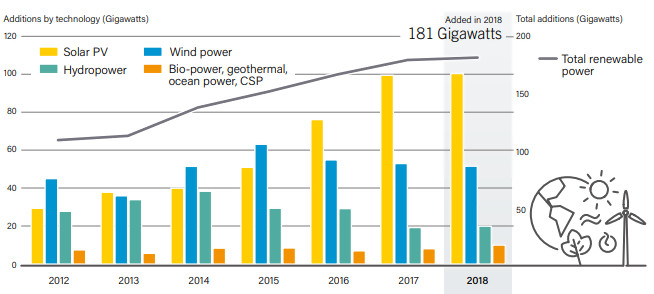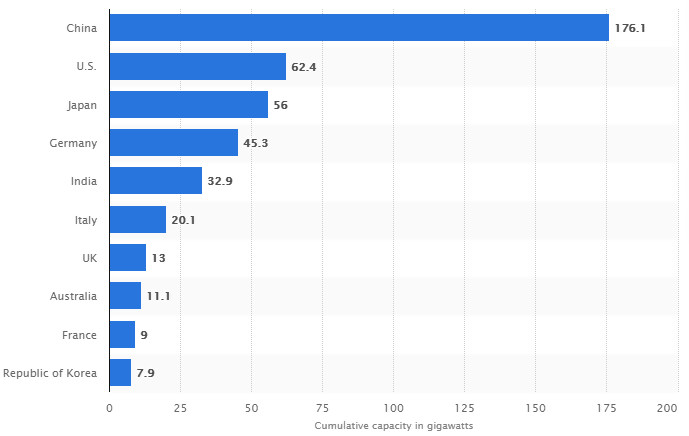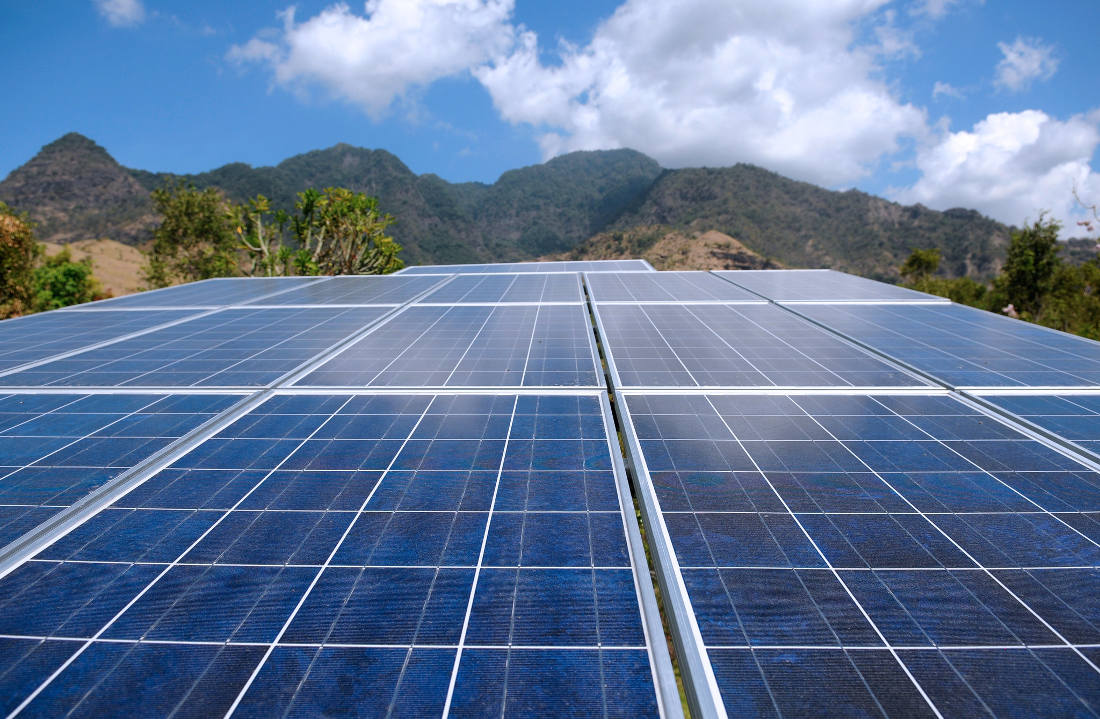Sheikh Zaki Yamani, a former oil minister for Saudi Arabia, once observed that the end of the oil age was near. Close to two decades later, the world seems to be as addicted to the ‘black gold’ as during the oil embargo of the ‘70s. Interestingly, the threat of a “cataclysmic crash in the price of oil,” as Sheikh Yamani predicted, is growing real as developments in renewable energy advance.
Globally, the power generated from renewable energy sources grew significantly in 2018. According to a report on the status of the global renewable energy industry by REN21, a global think tank focused on renewable energy policy, 181 GW installed capacity of renewable energy was added in 2018. More striking is that, globally, solar power accounted for close to 55% of the installed capacity added (Figure 1). Notably, the REN21 report noted that solar power now accounts for a little over 20% of the installed capacity of the global renewable energy industry.

As of 2018, the valuation of the global solar power market was $52.5 billion. Comparably, the market was worth $38.9 billion in 2017, representing an expansion of 35% between 2017 and 2018.
Interestingly, the market is set to grow at a higher rate this year on the back of falling prices of solar PV modules.
An increased number of governments are joining giants like China in developing policies that encourage production and use of renewable energy, specifically solar energy. Between 2012 and 2017, the aggregated value of the global solar energy market was $188.5 billion, according to data from GlobalData. Perhaps more interesting is that GlobalData expects the aggregated value of the market to hit $137.6 billion between 2018 and 2022.
Which countries are aggressively pursuing solar energy?
China is the king of solar energy. In 2015, the country deployed 15.1 GW of solar PV modules and later increased the capacity by 128% to 34.5 GW in 2016. China has continued to dominate the industry through the years such that in 2017, the country installed 53% of the world’s solar energy capacity.
As of 2018, China’s cumulative solar PV capacity was 176.1 GW, over 13 GW more than the capacity of the next three countries combined
(Figure 2).

Source: Statista.
The United States comes second after China in terms of installed capacity, investment in the industry, and market valuation. Since 2016, the amount of money put into the solar power industry by stakeholders in the US has been on the rise. In 2016, a total of $45.5 billion was invested in the industry. The amount invested rose through the years to $48.5 billion in 2018. Collectively, European countries invested $61.2 billion in the solar power industry in 2018.
What are the sectors where the application of the Solar Power Industry is most?
Various sectors across industry verticals are using energy from the solar power industry. According to the REN21 report, the heating and cooling sector is the highest user of solar power at 51%. However, heating is leading in terms of demand, and it is still growing fast. The transport sector is second in terms of demand for solar power at 32%. Mainly, road transport accounted for 75% of solar power demand in the transport sector. Also, 17% of the solar power demand goes to the power sector for lighting and powering other home-based electronics.
Since the industry is still young, there are not many companies competing for customers. However, this will change as the industry matures. In the meantime, some of the most significant players in the industry include NextEra Energy, Inc., and Consolidated Edison Inc., both based in the United States.
Industry outlook
There is a lot in terms of potential on the horizon for the solar power industry. Notably, the cost of manufacturing solar PV modules is significantly low compared to previous years. As such, solar power will continue to get cheaper hence increasing access. Interestingly, electricity obtained from solar energy is cheaper for many Chinese citizens than power from the national grid. Further, many more people are getting involved in the industry in terms of investing in startups. As such, technological advancement is likely to accelerate faster than ever before, which might push the cost of solar power further down in the future.





